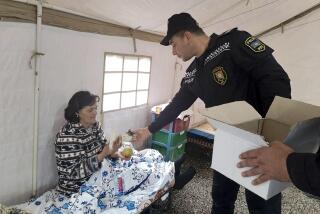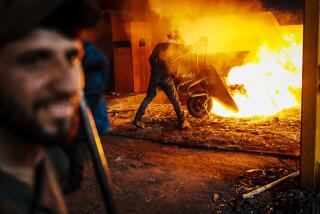Silent Men Speak to a U.S. Presence in Afghanistan
- Share via
GULBAHAR, Afghanistan — Four Western men in wraparound sunglasses and U.S. sportswear were on the sidelines watching and videotaping as anti-Taliban troops practiced for battle on a barren hillside Sunday.
When a journalist asked who they were and what they were doing, the men went deeper under cover of their Afghan head scarves and refused to speak. They ducked into a white van with blue curtains and sped off, and the Northern Alliance’s military maneuvers went on without them.
For days now, rumors that U.S. military advisors have been sighted here in the Panjshir Valley have swirled as wildly as the Afghan dust, but the silent observers standing near a row of about 15 opposition tanks had the look of the real thing.
Leaning against their van, they stared up at several hundred Northern Alliance soldiers as they blasted empty hillsides. The troops were in their second day of rehearsing for maneuvers scheduled for today, either as a huge propaganda exercise or a prelude to an offensive on the front north of Kabul, the Afghan capital. The United States’ fortifying of the alliance in the past week has stirred speculation that a major opposition push is imminent, but there are still questions about whether the fighters are ready to take on the Taliban.
One of the observers was wearing a Marlboro Classic shirt with the sleeves rolled up, exposing an expensive watch. Another had on silver Oakley sunglasses. All were dressed in chinos, and all sported Afghan scarves worn as bandannas or tied to cover the whole head, except for the designer shades.
When the reporter kept asking questions, the observers’ Afghan interpreter stepped in and said they spoke Spanish. A photographer present replied in Spanish that she did too, and still the men refused to speak.
The same men were spotted earlier Sunday in the white Toyota van with no license plates as they drove along a rough road in the Panjshir Valley. It was leaving an area where villagers said they saw mysterious containers dropped by parachute in the dead of night.
A four-engine turboprop transport plane flew over the Panjshir Valley about midnight Tuesday and dropped five containers, each with its own parachute, near the village of Jangalak, villagers said Sunday.
Each container was about the size of the bed of a pickup truck, and they landed on the southeast side of the Panjshir River, about as far from the road as possible, said Hoshang, 18, who uses only one name.
He said the sound of the plane awakened him and many others in his village of about 300 people. He watched from his window as the containers drifted down, and then he waited to see who arrived to claim them.
“The Americans came by themselves with a big truck and carried them off someplace,” Hoshang said through an interpreter.
Asked how he could tell they were Americans, Hoshang said that it was common knowledge in the valley who they were and that he personally had seen them at least three times driving one way or another on the rutted dirt track that passes through the valley.
Fewer than 100 U.S. Special Forces troops were believed to be in Afghanistan last week when Secretary of Defense Donald H. Rumsfeld said he planned to increase that number by three or four times.
Despite public acknowledgments that U.S. soldiers are in Afghanistan, the Pentagon has said little about where they are or what they are doing, beyond helping to identify targets for bombing raids and coordinating attacks with the anti-Taliban alliance.
Turkey announced last week that it was sending 90 special forces soldiers as military advisors to train Northern Alliance troops in mountain warfare.
U.S. May Direct Afghan Fighters in Offensives
As the U.S. deployment here grows, there is speculation that the soldiers may help plan attacks and direct poorly trained alliance soldiers in ground offensives on Taliban-held cities, such as Kabul and the strategic northern city of Mazar-i-Sharif.
The Pentagon has confirmed that it is considering, among several options, setting up a base in the Panjshir for several hundred U.S. troops to support Special Forces operations against the Taliban.
Washington has also said that it is airdropping ammunition and other military equipment to the Northern Alliance, which admits it has severe logistical problems compounded by early winter snows that are cutting off supply routes.
Hoshang and other villagers said they couldn’t see what was in the containers dropped last week, but they did report that the containers were taken deeper into the valley, toward the Northern Alliance’s helicopter base at Ahstana. The alliance’s main logistical base is in the opposite direction, in the Panjshir village of Baharak.
Tuesday’s airdrop was at least the second in the area, according to Hoshang, who said the first was on Oct. 25.
The Northern Alliance foreign minister, Abdullah, confirmed airdrops had taken place around midnight Tuesday, near Jangalak. But he insisted that it was “airdrops of food supplies in the Panjshir Valley” for civilians.
“This was coordinated,” he added, without elaborating.
Unlike many other parts of drought-ravaged Afghanistan, the Panjshir Valley is not known for food shortages. Farmers grow wheat and corn, apples and grapes, and their sheep and cattle graze in lush green meadows.
Aid agencies say they have enough supplies to feed several thousand refugees camped in the valley through the winter.
The U.N. World Food Program’s storage tent at Changaram, in the Panjshir, has eight metric tons of wheat in sacks stacked to the ceiling. At Rakha, the International Committee of the Red Cross has about 200 metric tons of rice, plus other supplies, to feed about 3,000 refugees until spring, manager Mir Akhbar said.
U.S. transport planes are dropping emergency food rations in areas where millions of Afghans are at risk of starvation. When a reporter asked Abdullah whether he was suggesting that the Panjshir was one such place, he said there was no shortage of food in the valley.
“If there has been some humanitarian assistance, it doesn’t mean that there is really a shortage of food. It is to prevent that,” he said.
There is circumstantial evidence that the Northern Alliance troops rallying north of Kabul for a threatened offensive are now receiving fresh arms supplies.
When some of them showed up for new uniforms imported from Iran, a longtime supporter of the Northern Alliance, most of the soldiers had the same old Soviet-era weapons they usually carry.
A rocket-propelled grenade mounted atop one launcher had Chinese characters on it and a number that indicated it was made in 1994. Another was a decade older. But one grenade stuck out because it was much bigger and looked new.
The white, stenciled markings designated it as an RPG-7 antitank weapon from “Lot No. 12-1-2000.” Nothing identified the grenade’s country of origin, but the words and abbreviations were in English.
Russia, another old ally of the Northern Alliance, reportedly plans to supply 40 tanks and more than 100 armored vehicles by the end of the year.
For several weeks, Northern Alliance political and military leaders have insisted that a new airstrip under construction on a desert plain about 40 miles northeast of Kabul is only for humanitarian relief flights. But they have begun to drop those claims in recent days.
A small, twin-engine turboprop plane landed at the new airstrip just after 3 p.m. Sunday, and witnesses said eight Western-looking men got out. They were greeted by Afghans and then got into a waiting vehicle and left.
White Plane’s Only Marking Is Tail Number
The plane took off about 20 minutes after touching down. The only marking on the white aircraft was the tail number: N6160.
The village of Jangalak, the drop spot for the mysterious containers Tuesday, is the birthplace of Ahmed Shah Masoud, the legendary “Lion of Panjshir.” He led the Northern Alliance forces until two Arab men posing as TV journalists assassinated him in September, just days before the terrorist attacks against the World Trade Center and the Pentagon.
The mere mention of his name still brings tears to the eyes of Afghans such as Hoshang, a cousin of Masoud’s. The commander was a man who preferred to solve his own problems, the teenager said, but he would have welcomed U.S. help for as long as it took to get rid of the Taliban.
Then he would have wanted the U.S. and other foreign soldiers to leave for good, Hoshang added.
“We will follow his path as long as we have enough blood left in our bodies,” he said.
More to Read
Sign up for Essential California
The most important California stories and recommendations in your inbox every morning.
You may occasionally receive promotional content from the Los Angeles Times.













